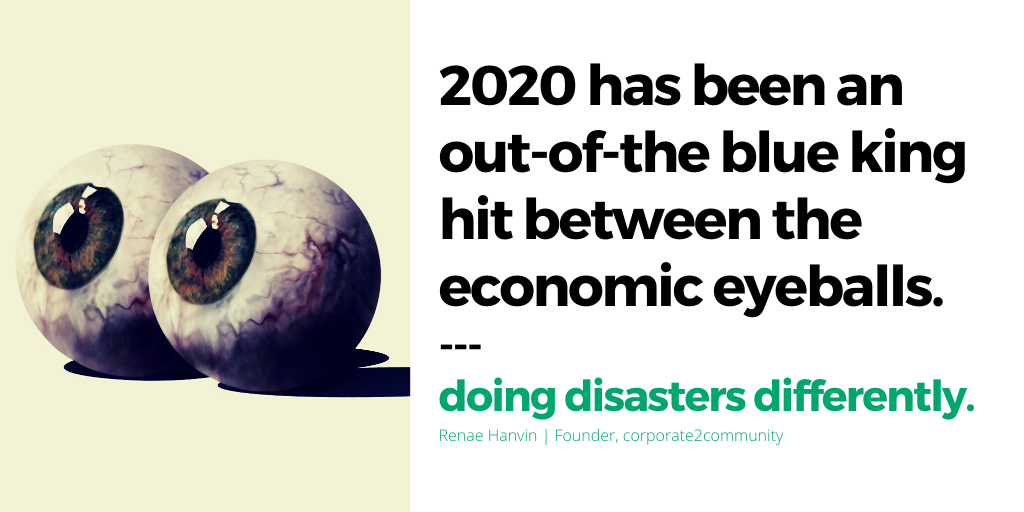King Hit between the Economic Eyeballs
One thing’s for sure, coronavirus has been the mother of all equalisers.
If the prolonged drought didn’t slowly ring every ounce of profit from your business, the
bushfires that farewelled an old decade and heralded in a new licked up every fat reserve.
If your business was still standing by late February, an invisible enemy that silently entered
Australian borders made sure you were on your knees within days.
Very few sectors, public or private, have escaped COVID-19. Its impacts on micro, small,
medium and large business is crippling.
Mass cancellations for hotels, restaurants and other tourism businesses began the rolling
wave. Enforced closure of non-essential services, and social distancing measures and
gathering number restrictions then made it impossible for others to continue. Mass staff
stand downs followed as businesses large and small went into hibernation unsure what the
future held.
Without a doubt, 2020 has already been an out-of-the-blue king hit between the economic
eyeballs that will leave the globe reeling for months if not years to come.
TIME TO REFLECT
We’ve all been asked to make sacrifices to help “flatten the curve’’, and everyone
self-isolating has certainly done that.
We’re blessed to have a government and robust banking sector with the capacity to help us
immediately. But, understandably, that aid comes with strings – we will all have to pay later.
In the meantime, where does going into hibernation leave business? More specifically,
where does it leave your business?
Will it flatten your business curve to the point of no return? Do you know how to prevent
that from happening?
By necessity, each sector is at a different stage in the COVID-19 disaster.
Some cafes, retailers and even service providers can be agile and have adapted quickly to
the changing situation.
We have seen a surge in restaurants axing fine dining menus to make way for pizza and
burger takeaways, gin distillers converting equipment to hand sanitiser manufacturing and
craft soap makers bundling product into care packs, taking advantage while supermarket
shelves are stripped bare.
Rule books have been closed, with Etsy storeowners, market gardeners and community
suppliers coming into their own with ready-to-go product while big hoteliers, airlines and
corporates wallow under the weight of cumbersome management hierarchy and stodgy
protocols.
For businesses on the brink with nothing more to lose, the lesson is clear: it is time to
unleash creativity, throw caution to the wind and give any new idea a go.
But that doesn’t necessarily mean end times for big business.
With more to lose, a more measured approach is needed for a company unable to make
snap decisions and suddenly direct its workforce to swap its skills.
Now is the time for brainstorming and thinktanks to rumble into action while the dust settles
and bean counters assess the financial damage because there will be little room for error
once decision become action.
Regardless of its size, each business should also make time to reflect:
-What lessons have you learned?
-What unexpected things happened?
-How can you be better prepared for next time?
UPWARD CLIMB
The good news is that growth always eventually follows a downturn.
We love this quote from the folk at McKinsey & Company:
Economic downturns are impossible to predict and sure as sunrise. Build resilience now, because when the sun comes
up, you’d better be moving.
The secret to success post-disaster is readiness.
Traditionally, the stages of focus across all stakeholder groups is the during (immediately
post-impact) and after (short and/or long-term recovery).
While the COVID-19 disaster did catch many unawares, it’s not too late to take readiness
measures now.
In March 2015, Australia endorsed the global blueprint, Sendai Framework for Disaster Risk Reduction (DRR) 2015-2030, in recognition of the need to plan upfront for how to survive
future impacts.
The DRR commitment means more focus on the before through:
1. Understanding disaster risk
2. Strengthening disaster risk governance to manage disaster risk
3. Investing in disaster risk reduction for resilience
4. Enhancing disaster preparedness for effective response, and to “build back better’’
in recovery, rehabilitation and reconstruction
To do this, leaders (including small business owners) need to think differently and lead
differently by understanding the DRR landscape and commit to a strategic future for their
organisation that aims to prevent new and reduce existing risk to help strengthen resilience.
But it’s not just about your business alone – it’s about determining the role you play in the
community before, during and after this disaster.
Forward thinkers don’t wait for government to involve them.
About Renae:
Renae Hanvin is the founder of corporate2community and a leader in private sector
contribution before, during and after disasters. Most known for ‘Doing Disasters Differently’,
Renae helps corporates, SMEs, governments and communities build disaster resilience to
all-hazards.
www.corporate2community.com


Recent Comments